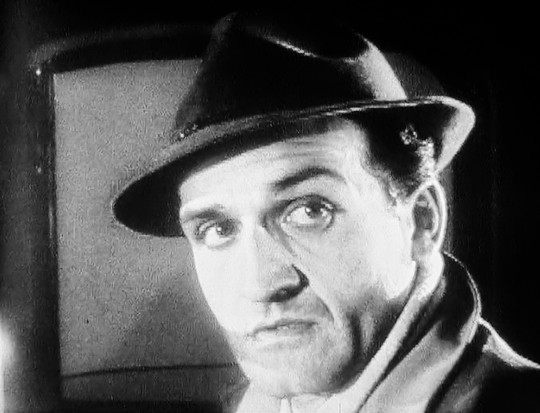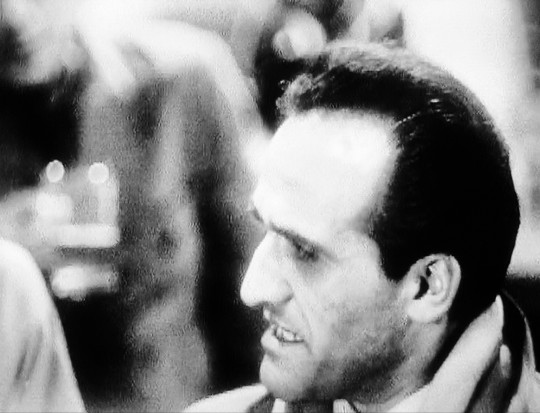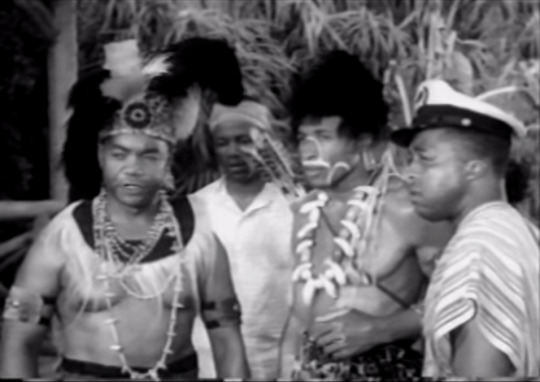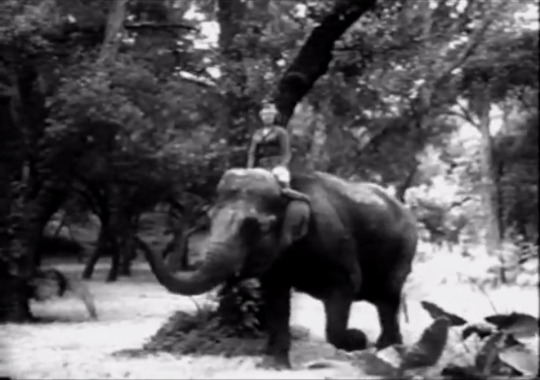#great cliffhanger). the serial almost feels like it has a guest of the week‚ with a significant character turning up for one ep only in
Explore tagged Tumblr posts
Text



A young Roger Delgado works to expose an otherworldly conspiracy, as newspaper columnist Hugh Conrad in Quatermass II: The Coming (1.4, BBC, 1955)
#fave spotting#roger delgado#the master#quatermass#doctor who#classic doctor who#delgado!master#quatermass ii#quatermass 2#images are rough i know‚ but that reflects the quality of the material to a degree#that we have complete copies of Quatermass II is a small miracle and to be celebrated#but as a bbc series from 1955 it is understandably in rather poor form as regards picture and sound quality#at least compared to contemporaneous shows from itc or america (largely shot on film)#anyway. what a delight to see young Rog! he's only in this one episode (although he can be seen briefly in the recap at the start of ep 5#and thus sometimes is credited with both) but he's playing a great character‚ a fleet street wonder that Quatermass brings in to try#and spread word about the conspiracy at the heart of the series. it allows Rog to play quite a different figure to the villains and foreign#dignitaries that became his stock in trade later on; he's a wily‚ astute but sceptical figure‚ who wants proof of Quatermass' claims and as#such is exposed to the alien horrors at work (allowing SPOILER for some very good 'battling possession' acting that leads into a truly#great cliffhanger). the serial almost feels like it has a guest of the week‚ with a significant character turning up for one ep only in#most installments‚ including Rupert Davies in the previous episode‚ but i think it's just the way the serial was formatted (and it's not#like Delgado or even Davies were particularly well known actors at this point in their careers)#still it's been fun to revisit. highly recommended for fans of dark and doomy sci fi horror
27 notes
·
View notes
Photo

Panther Girl of the Kongo
Panther Girl of the Kongo comes to us from Republic Serials, whose logo was mocked over and over every time it appeared in front of Radar Men from the Moon. It stars Phyllis Coates from Invasion USA and Myron Healey from The Unearthly and The Incredible Melting Man. It's also got giant lobsters for its monsters, and oh, yes, this is every bit as unbelievably silly as it was in Teenagers from Outer Space.
Our heroine is Jean Evans, wildlife photographer and vine-swinging Panther Girl! She and her crew are looking for a lion, but instead they find a giant crawdad that wrecks their camera! Understandably concerned (giant arthropods in the 50's were normally a sign of radiation), Jean calls up her friend Larry Sanders, a safari guide. Together they discover a truly diabolical plot: mad Scientist Dr. Morgan has discovered how to mutate arthropods into giants! What's he doing with them? Well, it just so happens that he's also found a hitherto unknown diamond mine, and is determined to scare the natives away[crustacean needed] so he can claim the land and have the gems all to himself.
There are thirteen episodes of this and almost all of them contain a furniture-smashing fistfight scene. I'm amazed they didn't run out of Jungle Hut props.

Let's get the technicalities out of the way first. Like Radar Men from the Moon, Panther Girl of the Kongo is designed around a series of cliffhangers – every episode must end with the hero and/or heroine in mortal peril so that the audience will come back next week to find out how they escaped. The answers are usually not exciting: at the end of Episode One (The Claw Monster!) Larry is knocked out by members of the evil Returi tribe while Jean is menaced by a crawdad. At the beginning of Episode Two (Jungle Ambush!) it turns out Larry was only momentarily stunned, fights off his attackers, and saves Jean in the nick of time. At the end of Episode Six (High Peril!), he appears to be about to fall onto spikes, but in Episode Seven (Double Trap!) we see that he actually lands well away from them. And so on.
The monster effects are... well, they're awful, but they're entertainingly awful. The crawdad attacking the miniature camera is pretty great, as is the one that's shown 'growing' by putting successively larger crawdads in a miniature cage! The giant puppet claws that reach out from behind rocks and trees to menace people are utterly hilarious – and of course we never see any blood on the 'injuries' these cause. And man, if you think the crawdads are stupid, wait until you see the movie's truly abominable gorilla suit. We saw better-looking shit in Season 11 Bigfoot movies!

There is a lot of stock footage here. Critic William Cline described the plot as functioning ‘to move the heroine from one piece of stock footage to another’. There's a sequence in which Jean promises some guests film of the strange creatures she's discovered, but adds that it's on the same reel as some of her other footage, which they'll have to wind through first. This is an excuse so that we can look at a bunch of documentary animal footage showing creatures like giraffes and cranes that definitely do not live in the jungle. There's a totally unnecessary recap episode. Jean's elephant friend Beela exists almost entirely in stock footage, and the same stock footage every time she appears (to be fair, this would have been way less noticeable in a weekly serial than it is watching the whole thing in a day). All the vine-swinging is from the earlier serial Jungle Girl, and is clearly a man in a dress and a wig! At least they matched the costume.
But we all know by now that what I love talking about in these pieces of antique media is their politics, so let's take a look at the political situation presented to us by Panther Girl of the Kongo.
We are shown two tribes, the Utanga who are Jean and Larry's hosts, and the Returi who work for Dr. Morgan. Do I need to specify that both are totally invented? No? Good. The prop and costume department gave these two peoples distinctly different looks, but these are designed less to suggest different cultures than to establish who are the 'good' and 'bad' Africans. The 'good' Utanga are a little Westernized. They wear textile clothing without much embellishment beyond Chief Danka's beads and feathered headdress, and live in houses with domestic animals such as chickens. The Returi, on the other hand, wear 'leopard skins' with body and face paint and jewelry made of bones and teeth, carry weapons everywhere, and seem to be a more nomadic hunter-gatherer tribe. The treatment is intended to dehumanize them, making them the obvious 'bad' guys.

The two tribes seem to coexist peacefully. As in Voodoo Woman it's the white people who have brought trouble with them as they seek resources. Voodoo Woman hinged on Dr. Gerard's quest for power and Marylin's for gold, while Panther Girl of the Kongo concerns Dr. Morgan's interest in diamonds. The gems are quite useless to the local people who own the land, but very valuable to Morgan. He can't ask permission to mine the area because he doesn't want to have to pay taxes or fees on his finds, so instead he sets out to steal the land. In order for him to get the resources he needs, the natives must be either driven away or enslaved.
The monsters are intended to frighten off the Utanga. With the Returi, Dr. Morgan employs a different approach – he keeps them compliant by providing them with a 'tonic'. Exactly what this is, we're never told, but it's addictive and mind-altering, making those who take it more obedient and less concerned with their personal safety. I expected this to be a plot point somehow, but it's never returned to. It is reminiscent of a number of situations in real-life history: the fur traders would give the Native Americans alcohol in exchange for beaver pelts, and the British would sell the Chinese opium for tea. Now that they're under his thumb, Dr. Morgan can have the Returi do a great deal of his dirty work, while blaming the violence on the 'primitive tribe' who don't know any better. When one of the Returi men is shot and hurt, he is simply abandoned despite his friend insisting that he needs help. In Dr. Morgan's mind the natives are either tools or inconveniences.
There's a thread of the White Saviour trope in the story, too. While Dr. Morgan considers himself the master of the Returi, Jean and Larry seem to think of themselves as the protectors of the Utanga. Jean says that with the monsters running loose in the jungle, the men of the village would rather stay home to protect their families than go out and hunt the creatures down, so the latter job is left to the white people. Indeed, Morgan's men are counting on this – they believe the Utanga will depart at once if Jean and Larry are killed and therefore no longer able to protect them. Later the Utanga actually do flee en masse, and the white people have to promise protection to make them come back. The government and police force who will solve the problem if Jean can only find proof against Dr. Morgan are also white – history would suggest that they're Belgians, but they speak with British accents. I guess the writers didn't research anything else, why would they bother to get that right?
In this case, I really don't think any of this is social commentary. It's much more superficial than it was in Voodoo Woman, and I get the idea that it was written this way because somebody just figured that was how things worked in Africa.

Another thing I find kind of interesting about the series is how, despite the jungle and savannah setting, Panther Girl of the Kongo often feels like a western. This may be mainly on account of the 'mining' plot – trade diamonds for gold or silver, give the two tribes faux-Native-American names instead of faux-African ones, and shift us from the jungle to the desert, and the whole 'chase the locals away from the undiscovered mining site' plot would work equally well. When we see a larger settlement than the Utanga village, many of the sets have a very 'wild west' feel to them, possibly even being hastily-redressed leftovers from a western movie. There are certainly plenty of shootouts and barfights that would be right at home in a cowboy movie, and probably contribute to the 'western' atmosphere. Such a story could even keep up Jean's friend-to-animals persona, having her hang out with bears and feral horses instead of lions and elephants. 'Coyote Girl of Nevada'? Why not?
The ease with which this could be done speaks to something else: the formulaic nature of the story. It's made of tropes, pieced together into a plot that would use (as Cline noted) as much of their stock footage as they could. The only reason it's a jungle story rather than a cowboy story was because they happened to have the jungle footage on hand. If they'd had stuff left over from Radar Men from the Moon instead of Jungle Girl, it might well have been a space story instead ('Rocket Girl from Venus'?). Panther Girl of the Kongo was the sixty-fifth serial Republic had produced, and like Disney with its princesses, they pretty much had their formula down.
But that's not necessarily a bad thing. If you just sit and watch it, Panther Girl of the Kongo keeps the animal footage and jungle peril coming steadily enough to keep you from getting bored, and the story is reasonably engaging. The monsters and gorilla suits aren't believable for a minute, but they're amusing, and the bite-sized serial format means you can watch a couple, get tired of it, and come back to it later, when the title cards will kindly remind you which heart-stopping cliffhanger you left off on. Each episode has a mini-plot that contributes to the overall narrative while also feeling acceptably self-contained, and Jean is a fairly capable heroine, saving Larry's life almost as often as he saves hers.
It’s not art. Indeed, it’s clearly a sort of assembly-line product, but I can see how this stuff made money.
#mst3k#reviews#episodes that never were#panther girl of the kongo#guys in gorilla suits#boy are we in africa!#50s#giant arthropod hours
11 notes
·
View notes